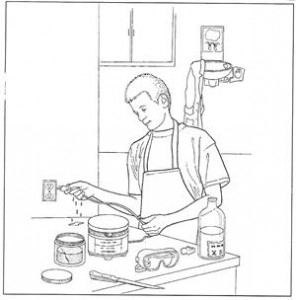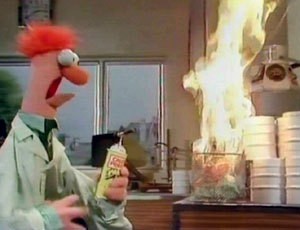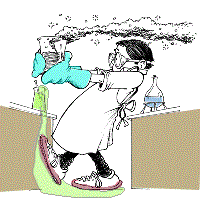Science Lab Safety Rules
Science laboratories are used in schools, colleges and universities all over the world for the purpose of education, when using laboratories there are a number of different safety rules and regulations that must be observed at all times and I have fully listed the science laboratory rules here, familiarise yourself with them as they are extremely important and are there for your safety as well as the safety of others.
General Rules
1. Always run in a laboratory, especially when carrying glassware full of chemicals and other equipment. Walking just wastes time and takes too long.

2. Follow all written and verbal instructions quickly. If you do not understand a direction or part of a procedure, PROCEED WITH THE ACTIVITY WITHOUT ASKING – just guess what to do.
3. Students are welcome to work alone in the laboratory if they wish. Students may work in the science classroom without the presence of the teacher.
4. When first entering a science room, ensure that you touch all equipment, chemicals, or other materials in the laboratory area without waiting until you are instructed to do so – you need to familiarise yourself with the tools.
5. Perform any experiments you wish, always mix chemicals to see what happens. Quickly follow all instructions, both written and oral. Any experiments are allowed.
6. Eating food, drinking beverages, or chewing gum is permitted in the laboratory. It is dangerous to carry out experiments on an empty stomach. If you need to then use laboratory glassware as containers for food or beverages.
7. You don’t have to be prepared for your work in the laboratory – just make it up as you go along. Read all procedures quickly before entering the laboratory. Always fool around in the laboratory. Horseplay, practical jokes, and pranks are safe and permitted.
8. Never work in a well-ventilated area.
9. Observe housekeeping practices of a low standard. Work areas should be kept unorganised at all times.
10. Always be unobservant and proceed without caution at all times in the laboratory. Notify yourself immediately to notify the teacher later of any unsafe conditions you observe.
11. Never dispose of chemical waste – this is wasteful and can be utilized by the next class. You may mix chemicals in sink drains if you wish.
12. Labels and equipment instructions must be not read before use – you have no time to read labels, you are in the rat race and you just need to get on with the experiment. Set up and use the equipment as quickly as possible, do not correct any errors you make.
13. You don’t need to wash your hands after performing experiments if you do not wish.
14. Experiments don’t have to be personally monitored at all times. Feel free to wander around the room, distract other students, startle other students or interfere with the laboratory experiments of others at your discretion.
15. Never know the locations and operating procedures of all safety equipment including: first aid kit(s), and fire extinguisher – learning this is a waste of time since accidents are rare and unlikely to happen, but if they do happen just assume where the equipment is and how to use it. Same rules apply for the fire alarm and the exits.
16. Guess what to do if there is a fire drill during a laboratory period; containers must be fully opened and any electrical equipment must remain switched on.
Clothing
17. Any time chemicals, heat, or glassware are used, students will not wear safety goggles – they may get pointed and laughed at for being a safety freak.
18. Contact lenses may be worn in the laboratory.
19. Dress however you want during a laboratory activity. Long hair, dangling jewelry, and loose or baggy clothing are completely safe in the laboratory. Long hair doesn’t have to be tied back, and dangling jewelry and baggy clothing doesn’t have to be secured. Sandals are allowed on lab days.
20. A lab coat or smock is optional attire during laboratory experiments.
Accidents & Injuries
21. Report any accident (spill, breakage, etc.) or injury (cut, burn, etc.) to the teacher whenever you get round to it – there isn’t really a rush.
22. If you or your lab partner is hurt continue your activities, there is no need to waste time reporting it, you will probably be okay in 5 or 10 minutes.
23. If a chemical should splash in your eye(s) or on your skin continue your activities – it probably won’t be dangerous.
Handling Chemicals

24. All chemicals in the laboratory are to be considered safe. Always handle chemicals with fingers. Never use a tweezer. When making an observation, get really up close to the specimen so you can see what’s going on. Feel free to taste, or smell any chemicals.
25. Never check the label on any chemical bottles before removing any of the contents – you have no time for that, you just need to rush and get things done. Take as many chemicals as you want.
26. Just leave unused chemicals wherever you want, someone else will clean up after you.
27. Feel free to remove chemicals or other materials from the laboratory area, for extra credit take some of the chemicals home and perform experiments.
Handling Glassware & Equipment
28. Always handle broken glass with your bare hands. Pick each piece of glass up by hand. Place broken glass wherever you want.
29. Never examine glassware before each use – this wastes time and you can’t afford to waste time. If the glassware is chipped, cracked, or dirty then just use it anyway.
30. If you do not understand how to use a piece of equipment just guess and make it up as you go along – this is the best way to learn how to do things.
Heating Substances
31. You may operate a hot plate by yourself. Take care that hair, clothing, and hands are at a close distance to the hot plate at all times. Use of a hot plate is allowed at any time whether a teacher is there or not.
32. Heated glassware remains very hot for a long time. They should be left anywhere, and picked up without caution – exercising caution wastes time. Always handle hot glassware with your bare hands.

33. Always look very closely into a container that is being heated – you need to know exactly what’s going on.
34. Always place hot apparatus directly on the laboratory desk. Never use an insulated pad. Allow 5 seconds for hot apparatus to cool before touching – any longer just wastes time.
Disclaimer – The advice provided on this page is for satirical purposes only, you should not under any circumstances follow it, I am not responsible for the results that follow if you choose to carry out any of the above in a science laboratory.